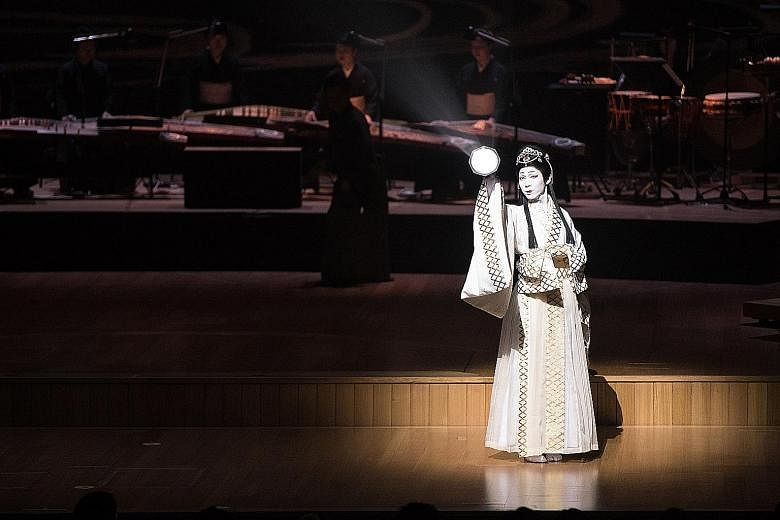REVIEW / CONCERT
HIMIKO: MEMORIES OF THE SUN GODDESS
Esplanade Concert Hall/Last Friday
Himiko: Memories Of The Sun Goddess was the centrepiece and climax of the Super Japan - Japanese Festival of Arts, organised in collaboration with Esplanade to celebrate 50 years of diplomatic ties between Japan and Singapore.
Premiered in 2014, this ambitious musical and dance epic based on Japanese mythology composed by Yoshihiro Kanno was staged here to also commemorate the 30th anniversary of Tokyo's premier concert venue Suntory Hall.
The monumental 90-minute work unfolded in two parts, first a Japanese version of the earth's creation and, second, the legend of Himiko herself.
The ensemble conducted by the composer comprised a central koto ensemble with percussion, flanked by another traditional Japanese group (plucked strings and winds) and a Western suite of cellos and basses. Fronting these were two soloists, violinist Yasuko Ohtani and cellist Tsuyoshi Tsutsumi.
Given the religious nature of Japanese cosmology, a chorus of 16 monks (or shomyo) from Daihonzan Zozoji Sikisikai provided the show's ritual elements, including unison chants within two rousing processions, both imposing and festive.
The troupe of nine buyo (dancers) were led by Kotaro Nakamura and Umeya Nakamura, who shared the role of Himiko. This duality hence androgynous nature of the kabuki goddess meant she possessed masculine strength and feminine grace.
Kanno's starkly beautiful music - tonal and ruggedly hewn - was a fusion of East and West with 20th-century elements, recalling the harmonic austerity of Britten, tonal radiance of Messiaen and ethereal spirituality of Takemitsu.
An unusual opulence emanated from this heady combination. Ohtani's virtuosity was kept in the forefront, while Tsutsumi's deeper hues and his band of low strings (with mostly Singaporean musicians) provided a stirring backdrop.
Even Hanako Nakamura's sho (the Japanese sheng) and Evelyn Lim's pipe organ shared a timbral kinship that was cannily planned.
The work's 11 movements were well-contrasted in feel and movement, and even when stillness and stasis were key, there was neither drag nor did the action overstay its welcome.
Some movements were particularly effective, such as the harrowing percussive beat in Yomi No Kuni (Hades), when forces of darkness threatened to overwhelm those of light. In Nisshoku (Eclipse), the white and gilded trimmings of Himiko's costume were similarly shadowed by apparitions cloaked in dark blue.
Momentous but transient events such as solar eclipses were sources of fear and uncertainty for early man, for which faith and religious convictions served as a panacea. The shomyo's unison Tsuki Ni Inoru (Prayer To The Moon), a statement of conviction, was to bring the darkened hall back to glorious light. A final apotheosis in Fukkatsu (Resurrection) was equally emphatic and elicited a standing ovation.
The legend of Himiko, with rebirth and renaissance as a constant theme, was also rich in symbolism. It represented the resilience of the Japanese people, who have had to overcome the horrors of nuclear catastrophe and natural disasters over the years. The unquenchable human spirit was clearly its universal and abiding message.
Correction note: An earlier version of this article stated that Himiko: Memories Of The Sun Goddess was staged in Singapore to commemorate the 40th anniversary of Tokyo's premier concert venue Suntory Hall. It was in fact the 30th anniversary. We are sorry for the error.

